Day 9 | Zagreb - the capital (quick tour around)
The last days with Madoka. Short tour around the capital's historic center and time to say "Sayounara". With this article I finish the Croatian-Japanese adventures with Lions Club in both Japan and Croatia for the summer 2016.
Day 9 Zagreb - the tour around the capital
Bus ride to Zagreb
It took us about 3 and something hours till arriving to the Main Bus Terminal in Zagreb. The fun already started in the area around Vodice. Madoka and I both had seats of course but in the beginning were not sitting together (just for the first 20-30 minutes). I sat next to one male student from the island of Murter and in front of us was some pretty noisy, loud and boring grandma who could not stop talking about her daily life and activities. The guy sitting next to me told me she could not keep her mouth shut since Šibenik. Luckily she left a little bit earlier before we reached a station which would leave for the island of Murter and other places. Once we got rid of them (both the grannie and the student left) I told Madoka to sit next to me.
I got suddenly scared of having left our food and drink in the kitchen in our house but they were under my feet so everything was great. It was a pretty terrifying 30 seconds in the bus.
We slowly watched how the landscape was changing, abandoning the typical Dalmatian one and approaching the mountains where the "change in vegetation and climate" would occur. We had a break after an hour or so to go to the toilet and eat something.
Later on Madoka fell asleep. I might have listened to the music and my eyes closed as well a few times which helped me save the time. It was hot outside but comfortable in the bus. Still was lucky to have the bottle of water to refresh myself every now and then.
We had no more fun moments in the bus. After all, this was not the regional bus and we left the "temperamental" regions. Soon one would notice more of greenery around us as we were going close by the NP Plitvice Lakes and approaching Karlovac. Then an hour and less left until Zagreb.
To skip the boring part we came about 12. 30pm to Zagreb. Familiar buildings and streets! Madoka was also awake. Few more minutes and we arrived to the main bus station.
Back in Zagreb! Going home and then meeting grandparents for the lunch again
Ugh, what I really started hating actually is our Bus Terminal. Probably one of the top ugliest buildings in Zagreb. And it is really a shame. I hope they raze it to the ground and build a new one. I always feel ashamed when foreigners come there and see it.
Since we had lots of stuff with us I did not want to risk not buying the transportation ticket for herself and myself. So I told her what to say when trying to buy the ticket and she went to the 'TISAK' store and told the old guy "Jedna karta tramvaj, molim! " (One ticket tram, please! ) haha and the guy inside was also smiling and happy.
It took us cca 15 minutes to our neighbourhood. We lef the cases and backpacks there and headed to my grandparents to Jarun for the lunch. Afterwards I planned to make a city tour as much as we could see in the following 3 hours before darkness.
Going to the city center first. Zagreb during the mid-August
After having lunch again we headed to the city center by using the number 17 Borongaj. I wanted to make sure we visit all the important things around the Old (Upper) town. I also kept on my mind thing that more or less everything she sees here is a bit different than in Japan.
Speaking of the city itself and the situation in summer Zagreb was kind of still a bit empty. If you are planning to visit the capital in July or especially from the mid-July until mid-August you will find some places during the day and in the evening to be like the ghost town. The reasons for this is that the majority of the citizens who work have the holidays during the end of July and August. More or less these 2-3 weeks of yearly holidays are going to be during this period. But this also includes the high school and the University students. For the high school students summer holidays in Croatia start in the middle of June and then we they have 2 and half months before the new school year starts in September. The Uni students in general are done with the lectures at the end of June and then in the following 25-30 days is the exam period or exam weeks. The autumn exam period starts at the end of August and lasts until the end of September. In general. So that's why the city is a bit empty. Students go to to the countryside or to the coast, many of them come from different regions of Croatia to study in Zagreb and the adults who work use their free time to escape from the city.
Personally, I am not sure whether I like the half-empty Zagreb. It feels very strange to walk on the main square "without soul". The whole city center seems like a graveyard unless there are some festivals going on. Last years I tried to be more in Zagreb during August which we all normally spent on the coast (my record was I believe 2 months and maybe a bit more... that happened after the first high school year was over in 2009... and this summer I spent only 8 days there)
Dražen Petrović and FC Zagreb
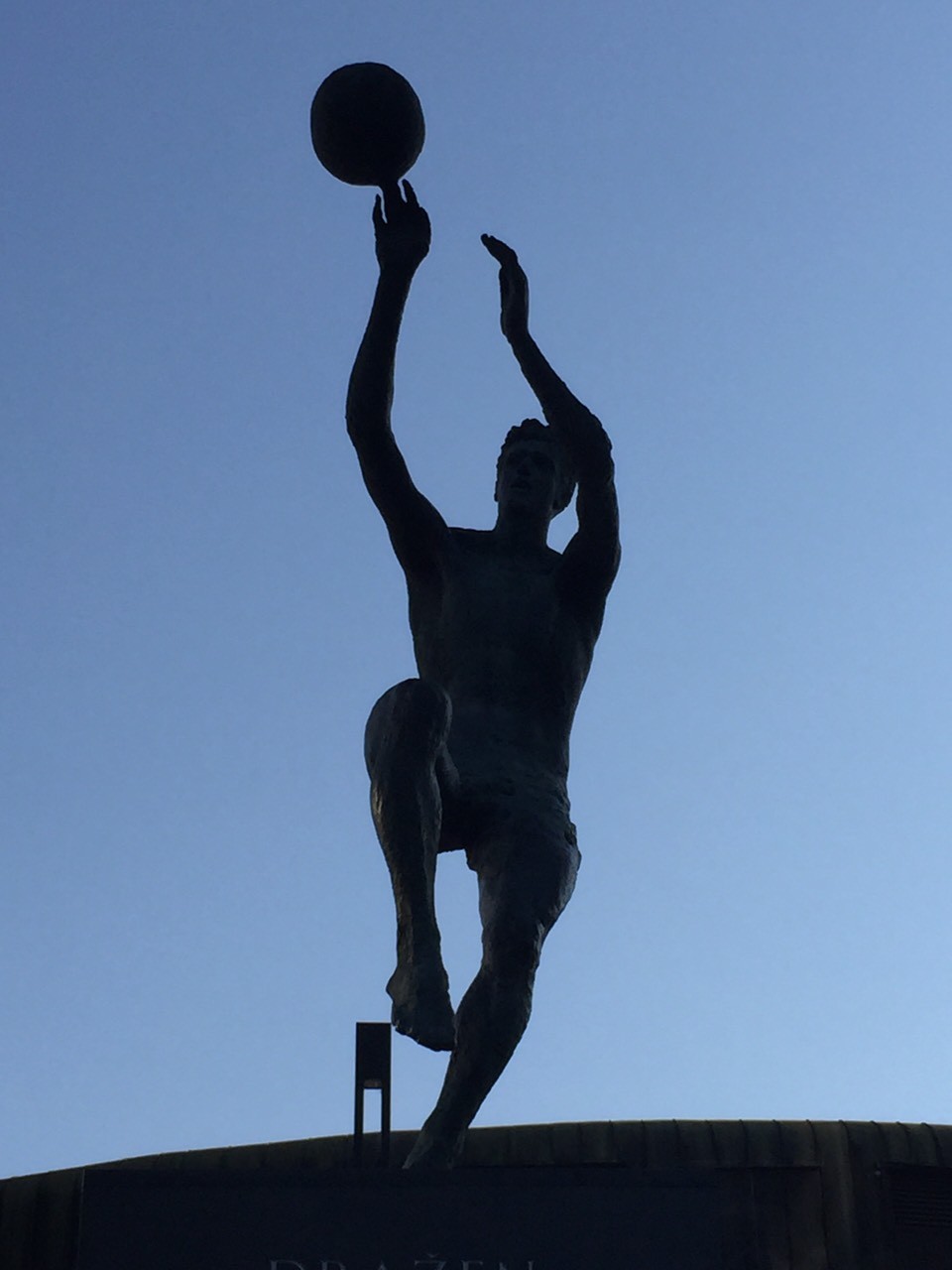
We left the tram at the station 'Studentski centar'. I thought it would be good if I show her a few things around. First we crossed the road and went under Cibona Tower. Cibona is a basketball club. There was the statue of infamous basketball player from Šibenik (again one from the coast, if you remembe the stories about the sportsmen) - Dražen Petrović. Then we headed more to the west until reaching the bridge of the railway and going under it to the other side. There was the graffiti of the football club Dinamo Zagreb. And we were about to have a quick view on the stadium of FC Zagreb (not that popular and good in sports as Dinamo). It took us 2-3 minutes to get there, it was empty and we could only see it through the fence. Okay, back to the tram station.
Technical Museum and the Student Center Zagreb
Being back there at the crossing of the big and long Savska Street and the road that led to the western part we decided to go in direction of north and the city center. To our left now was the Technical Museum. We entered the garden but had no time to actually visit any of the bigger museums unfortunately. At the entrance there is an old tram vagon and a CityBike station. There are several statues of important historical figures who contributed to the world of invention and science. And you can find a huge anchor right next to the entrance gates of the building.
We came back to the road and crossed to the other side. I wanted to show her a little bit of the Student Center. The entrance from the Savska was opened and I saw many other students walking around so we entered the yard and made a little circle around. SC is a popular place with a cinema and a hall for about one thousand people, there are a few student restaurants including the fast food line and the confectionery. During the semester it can be pretty crowded and you have to wait up to 20 minutes in the row and then have troubles finding a free table. There are also other rooms and quarters such as one called Student Servis where you go with the contract. Personally I hate that place and I believe I am not the only one since some of the staff working there are pretty arrogant and deserve to be kicked out.
After visiting Student Center we went back to Savska street, passed by the numerous cafes and the second railway bridge that cut the street almost under 90 degrees.
Sudden change in the urban landscape
Once we passed by the railway bridge the architecture suddenly changed. This is what I call the portal between the Old historic Zagreb and the one that was built mostly mostly after the First Wolrd War and especially after the Second World War. The architecture and style we saw now was the one you will find in all the other places of the former Austro-Hungarian Empire.
I decided to leave the tram at the station "Rooseveltov trg" so we could walk past the other important buildings and landmarks of Zagreb on our way to the main square.
To our left was now the big Mimara Museum and behind it was my Faculty of Architecture. But we did not go there. We followed the street and the tram lines to the other side.
We were now at the Square of Marshall Tito. To our left was the Museum of Arts and Crafts along with the School of Applied Arts and Design. More or less all the square looked pretty much unified with the archtiectural style except for one place. It was the new modern Music Academy which was totally outstanding with its facade. I think there are not many fans of it in Zagreb. It has especially one ugly roof that looks like a rainbow. And totally destroys the experience and feel once you see it from some view point from the Upper Town. In the middle of the square there was one of the symbols of Zagreb - the Croatian National Theater which is always going to catch your eye once you are there. We went to the main entrance to take some photographs. There is also the sculpture called "The well of life" by the sculptor Ivan Meštrović in front of the theatre. Further more, in north of the building on the other side of the road there was the main building of the University of Zagreb - the Faculty of Law. There are 2 more buildings for the law students nearby. To the west of the theatre there was a popular cafe called "Kazališna kavana". We went to take some photos of the facade of the main Uni building and walked up the stairs to see if the doors were opened. Unfortunately the entrance was closed.
The story behind the National Theater
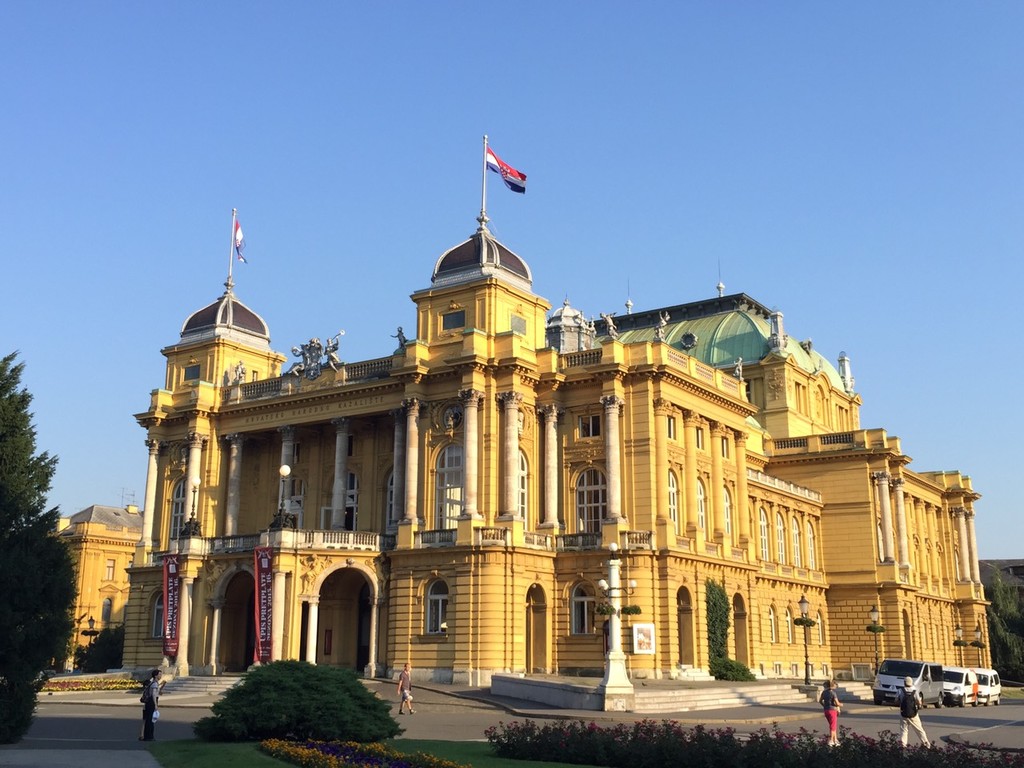
The National Theather was built around 1890 and actually done within very short period of time. It was meant to be opened on the day the Austrian emperor Franz Joseph came to Zagreb. But during this period there were high tensions between Croats and Hungarians. Hungarians had at the time the upper hand in politics and wanted to make a little surprise. But uncomfortable for the Croats. The plan was that they bring the Hungarian sand to Zagreb's Main railway station where the emperor would arrive to thus his first footstep would on "Hungarian land" but not in Croatia. Of course, it was impossible then to avoid the conflicts on the streets. The Hungarian flags were burning, there was a fight between the Croatian and Hungarian supporters, some people were injuried and even got killed. But in the end the Emperor came to the grand opening of the theater and everything was okay.
Ilica - the longest street in Zagreb
We now continued walking towards the north through Frankopanska Street. There was my School of Design so we stopped there. I wanted to show her a bit of my place where I study and do something. The exhibition hall was closed but we saw the poster of Mladen, one of the friends from Šibenik and Split and took a selfie in front of it.

We were heading now to Ilica street - the longest street in Zagreb which would lead us to the main square. On our way there I showed Madoka a few more popular bars in the street where we from Design would hang out when having a break or study before the exams. One of them is Cafe Zrinski. In the Dalmatinska Street which is 10 meters before my School there is also another popular bar called Cafe bar 13 or we call it "Trinaestica". There you can drink a cup of coffee with milk for about 9 kuna (cca 1. 3 Euros) and the waiter, an older guy, is also very friendly which is important for me thus you can feel pretty comfortable sitting there. I hate it when the waiters comment or try to be funny (or stupid actually... ) with what you have just ordered. That is the worst and makes you tell them "who pays here? you or me? " (insert rude word). The second are those who try to make you go away a minute after you had drank already everything. Luckily, the majority of them in Croatia and in Zagreb (as far as I know) are not like this but you can sit with one ordered coffee for 2-3 hours more. Noone complains.
Now let us go forward towards Ilica Street. It takes about 4-5 minutes walking till you reach the Main Square - Trg bana Josipa Jelačića. But go to the right otherwise you will be heading towards the wrong direction and go to the western part of the city. I could write you now a lot about Ilica and what it hides, its history and geography. It is the longest street in Zagreb with the length of almost 6 kilometers! That's more than the main road and avenue that goes through Novi Zagreb (from the western tram bridge over the river till the last on the eastern side). It is also very old and connected to the historic town and the oldest neighbourhood.
But I would tell you only what is within 500 m on both sides. If you go to the left (the east) you will come across numerous backeries, one art tool shop called Prosvjeta (a bit expensive but the art and the design students need it) and on the other side is the passage to Swanky Bar and Hostel. Is became pretty popular recently not only among the locals (and the students of design) but among the foreigners as well. It consists of the both interior and exterior. Personally, I have been there always when the weather allowed to be outside. Once you go through the bar to the other side where the yard is, you climb up the stone stairs and find yourself on a nicely decorated space. It has improvised chairs and wooden tables such as using the barrels to sit on. The waiters are also very friendly.
Coming up next there is a market place at the Britanski trg (the British Square). On Saturday morning there is a flea market where you never know what you can find. Speaking of the biggest flea market in Zagreb's area (and maybe in this part of Europe? ) it is Hrelič in Novi Zagreb, about 20 minutes by foot from the tram station Zapruđe and the bridge.
Right after passing the Britanski trg you will see Kačićeva Street which leads you to the Faculty of Architecture and other faculties in the area. Two more minutes from the Britanski trg is the Academy of Applied Arts (one of two buildings). And I would turn here back to the other side that leads to the main square.

Right there at the crossing Frankopanska-ilica there is Konzum shop and on the other side of the road the passage that will lead you to the big park behind (that goes to Tuškanec) and the Hemnigway club & bar. If you are an Erasmus student you will highly likely end up there at least once when ESN Zagreb organizes some event.
On our way to the main square there is also the big Kraš (chocolate factory) shop where you can try different sorts of chocolate. Next to it is Vincek confectionery, one of the best in the city and with a long tradition.
Tomićeva Street and the funicular beneath Lotrščak Tower
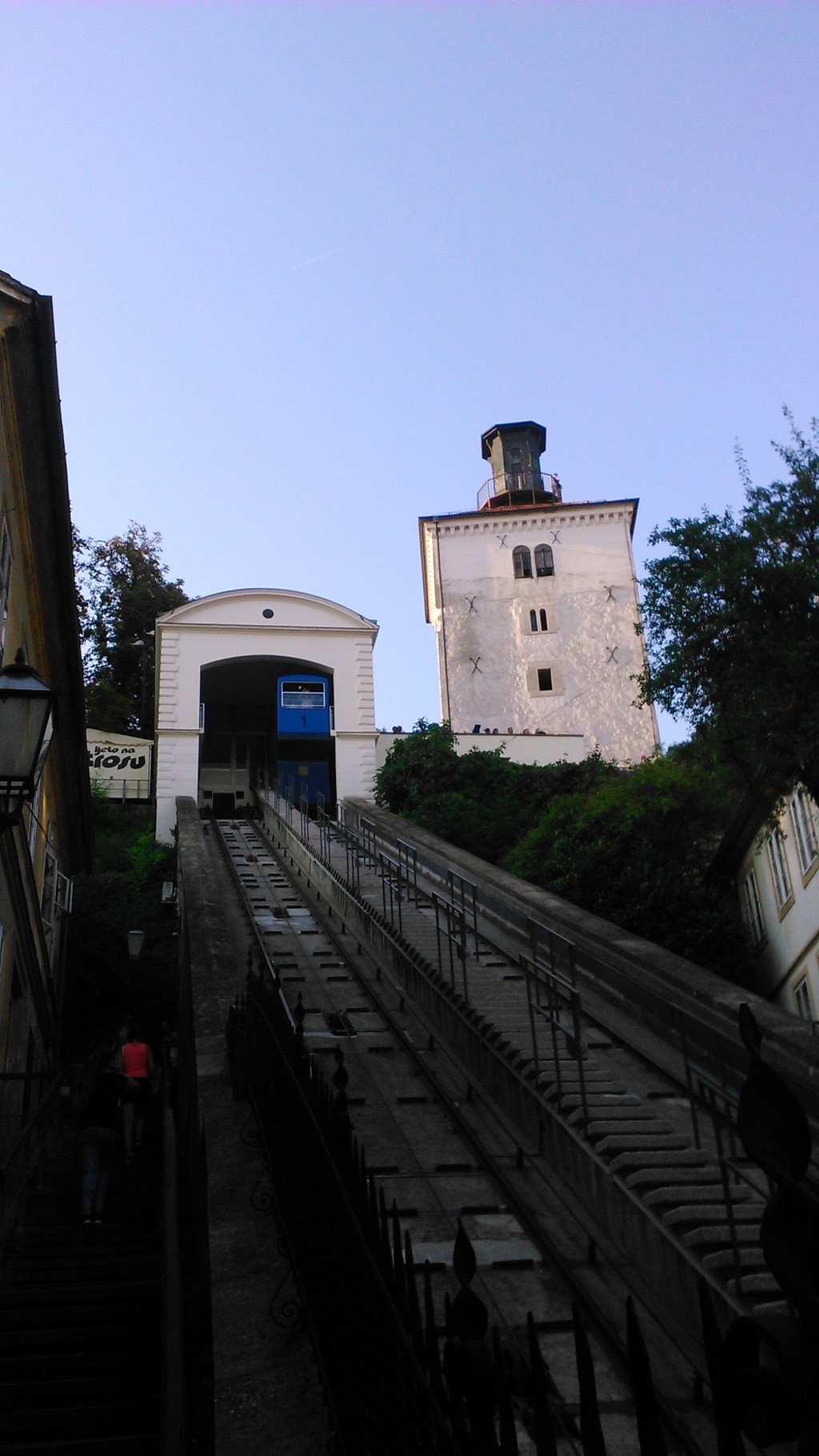
But we did not go to the main square right now. :P Why? On half of our way, where Vincek confectionery is situated, is Tomićeva Street. And whether you are a tourist or a local you will always stop or look in direction of Tomićeva. Because there at its end (it is a very short street, almost a blind street I could say) is the funicular called 'uspinjača'. And above it you see the tower of Lotrščak.
Every time I am with the foreign friends or tourits (or Croats not from Zagreb) around the center I take them to this place. And that can mean climbing up the stairs till reaching the tower and the nice view point or going from it downstairs and ending up in Ilica (or Vincek! ). The funicular will get you up on a short ride for several kunas (and during the winter holidays it is free! ) and you have the stairs from both sides of it that lead you up. There is also a small tunnel beneath the funicular that connects the two stair paths and is filled with messages. If you have time stop there and closely pay attention to the wall. The rest of the a bit tiring trip are the last stairs that lead you to the road which goes down to the other side and towards the main square. And the other side (about 20m) goes straight to the tower, the entrance to the funicular, the Strossmayers' promenade and the nice view over the Zagreb.
Under and on the Lotrščak Tower
Lotrščak [Lotar-ščak] is one of the landmarks of Zagreb and almost always comes in "a package" with the funicular. It is one of the best preserved parts of the fortification system of Zagreb in the several last centuries. The tower is today mostly famous because it fires from the cannon through the window every day at noon. The cannon is knows as Grički top (The cannon of Grič) So if you happen to be in the center at 12pm and especially around the area of the tower do not get scared (or a heart attack) once you hear the "explosion". At least you will know what time is it. :) There is also a bell on the top of it (and you can go around it if you pay for the entrance).
The name comes from its function in the past and that was "the bell for the thieves and bandits" as there were the town's walls and the citizens would be warned in case of the attack or problems with the bandits. As for the cannon on the 2nd or 3rd floor (you can see it from the outside on the window) the legend says that it saved Zagreb before the Turks when they were going to occupy. One of the Turkish army leaders was having lunch in his tent on the other side of Sava river when he heard the shoot from the cannon. The unexpected cannonball hit the Turkish headquarters and the tent and had slain the rooster that was being prepared for the pasha. The Turks started to run away and (of course.... ) never came back again and gave up from conquering Zagreb. So... thank you Mr Cannon, according to the legend had there been no cannonball we might have spoken Turkish today. haha
I decided to take Madoka on the top of the tower (which is in total about 30 meters tall! ) so she can see what Zagreb looks like from above and the Upper town. Before that we stopped a little at the viewpoint (just a fence with the maschine where you pay to use the binocular.. ) where I showed her the path we took, where we came from, where Novi Zagreb was and our grandparents. It is never boring to be there expect for the annoying moment when you notice the roof of the new Music Academy...
But let's climb up the tower!
Once you enter it there is a small souvenir shop and the place where you buy the ticket to go up. It costs 20 kuna (about 2. 8 Euros) per person and the do not have any discount for the students (I believe for 10 kuna 10x more people would love to go there... but the locals avoid it I think). You have then several floors to visit. There are stairs that go spirally to the very top of the tower and there are many windows on your way there so you can see how people get smaller and smaller as you climb.
On each floor there is sort of a modest gallery with several posters and some interesting facts about the place and history in both Croatian and English. On the 3rd floor should be the cannon but you cannot enter the space around it nor touch it. It is surrounded and locked with some room of glass and only the man who fires from it at noon has the keys. There are windows on every floor to almost all sides of the world and the most interesting ones are those that look upon the street that leads from the tower till the St Marko's Square and the one towards the south - the view over Zagreb.
FInally, the last floor is probably going to be the best one. Or I should say the platform? The more narrow space and stairs (wooden ones now) lead you from the last floor and gallery now up around the mentioned bell and to the platform where you can make a 360' circle. Now here we stopped for several minutes. It was my second time to be on the top of this tower and besides explaning Madoka where was what I also wanted to enjoy the view again. And we were still chasing and enjoying the sunrays in the evening so everything looked a bit golden. I guessed we still had about an hour and half of sun before the sunset and the nightfall.
What can you see around?
To the north you can see the church of St Marcus (Marko), the Parliament House and the House of Government. You will also notice lots of greenery and the slopes with houses which eventually lead to the slopes of Medvednica mountain which protects Zagreb from the north. The Upper town and the oldest settlements were technically built ont he slopes of Medvednica (far from the top of course). There to the NW is the cathedral, Ribnjak park and the hill with Sports-recreational center 'Šalata'. Again, a bit far away is the outstanding building of the astronomical observatory.
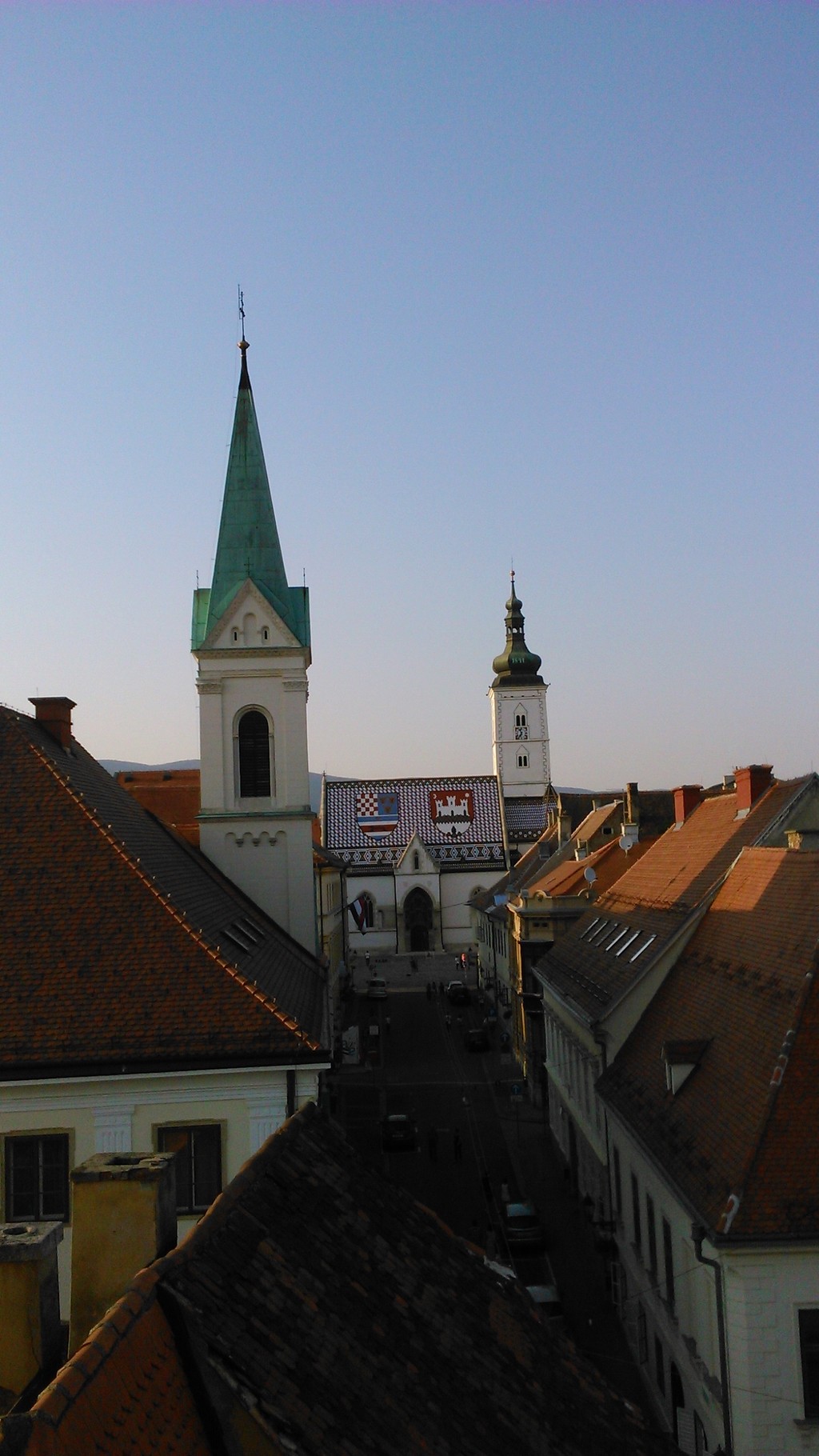
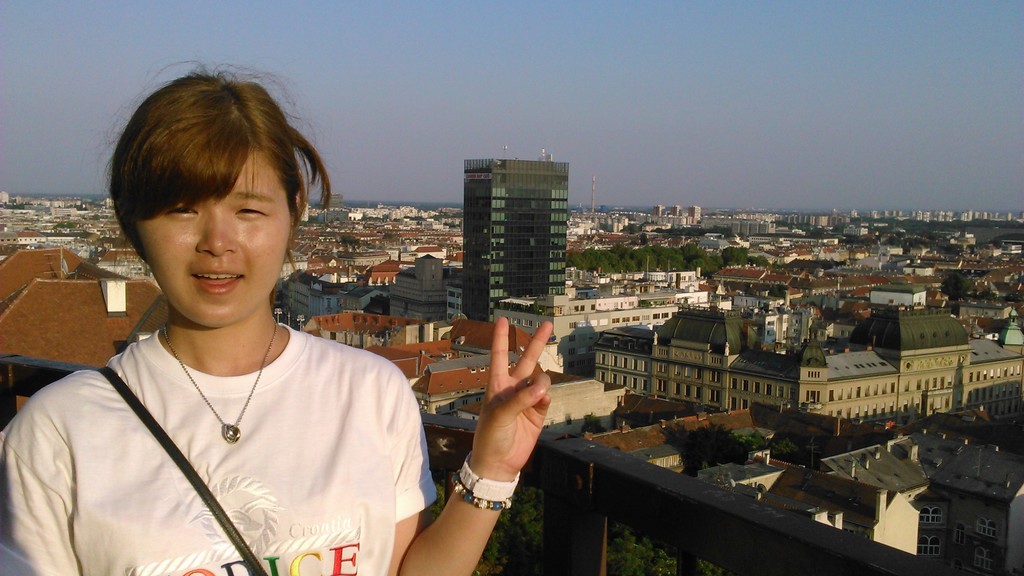
Next to the cathedral there are few more churches and then the skyscraper (Zagreb View Point) at the main square (which we don't see because of the buildings). Rotating further towards the south you can see how long Zagreb actually is. It stretches far to the east and west. The most narrow part is right there - between the city enter and the river. It is about 3, 5 km between the tower and the dyke of the river. But it is more than double distance to the end in the west and in the east. Zagreb is the central European city which means skyscrapers are not part of the tradition. Except for the one on the main square and some new ones far form the center in the business zones. You can see the funicular straight ahead and Ilica with the trams going left and right. Further more is the greenery of Zrinjevac park and glimpses of the Main Railwaystation. Far behind is Novi Zagreb and its skyscrapers. To the west we see mostly trees and forest of the Strossmayer's promenade and Tuškanec. I do not remember much of this part because I usually do not go there and do not care much.
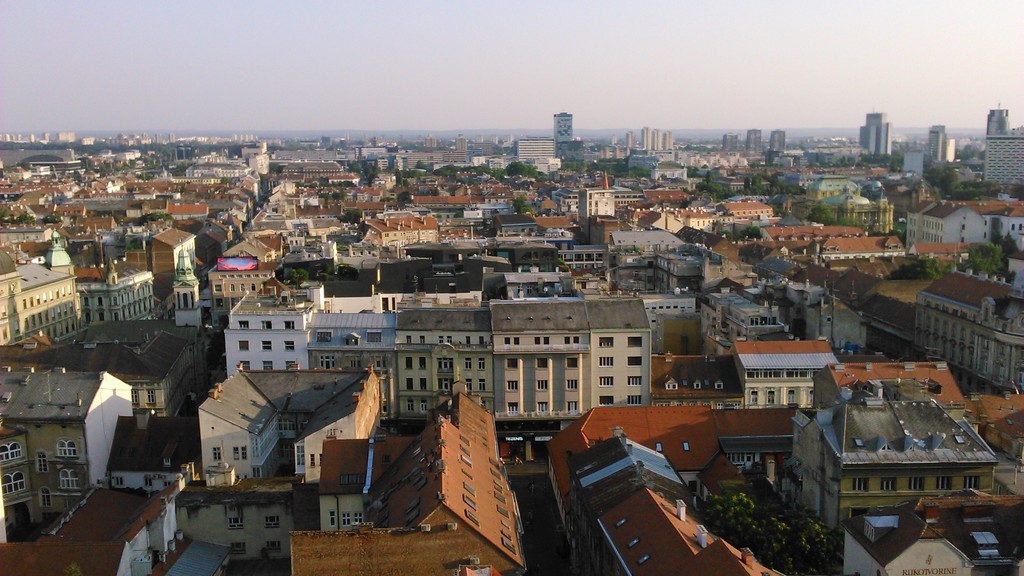
After taking lots of photographs we climbed down. Through the window I saw the girl dressed in the Northern Croatian clothing (red-white with patterns) so I wanted to ask her for a picture with Madoka. She agreed and there in once picture you had both Japan, Vodice and Zagreb all-in-one. Madoka was wearing the t-shirt we bought her in Vodice so it was funny to see it go around in the capital.
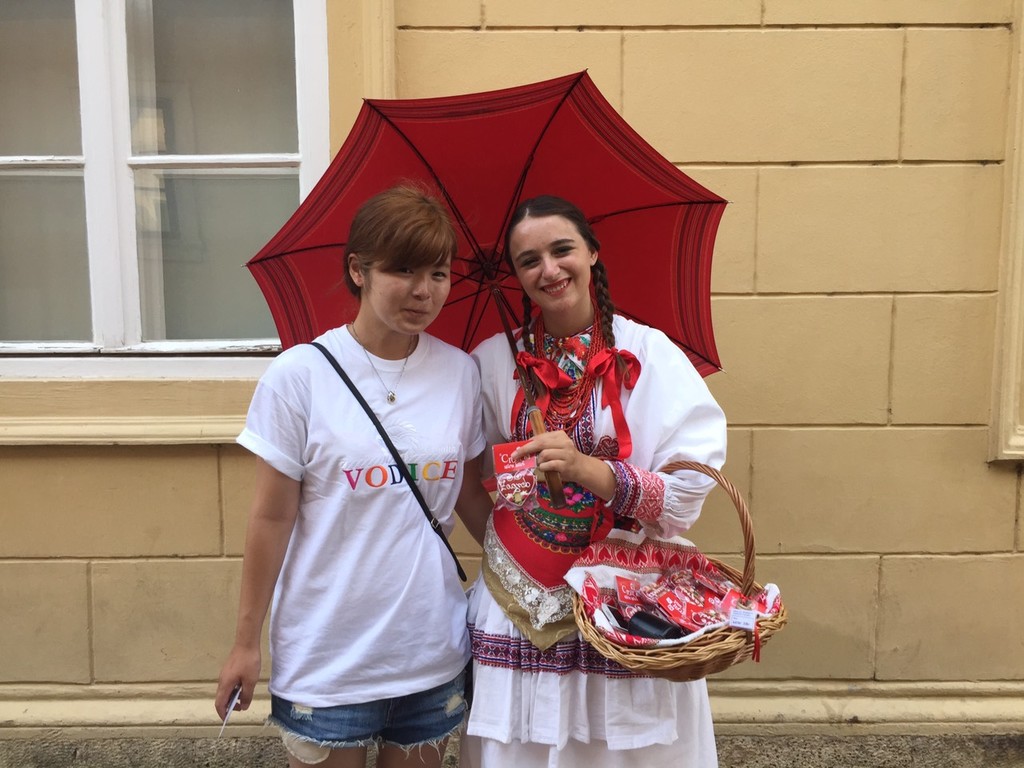
The Square of St Marko
The next thing I wanted to show her was the Square of St Marko (or Marcus... we call it "Markov trg"). There are the church with the same name and colorful roof, the Croatian Parliament (Sabor) and the Croatian Government. One could say that this is the place everyone dislikes or hates in Croatia, haha, if you understand what I mean.
On our way there you are going to cross Katarinina street where to your right is the square of Katarina and the Church of St Katarina (Cathrine). Next to it is the Gallery of Klovićevi dvori and one garden where in summer the open cinema is being organized. You can also find the stairs that will lead you back down to the ones going to Radićeva Street and the main square.
But we did not go there this time. Heading up forward to the administrative center you will pass through Ćirilometodska ulica. There are three important things to pay attention to. You can visit there the very popular and highly rated Museum of Broken Relationships. I have never been inside though so I cannot tell you personal experience but the other say it is very cool and a must-see in Zagreb. On the other side of the street you will find the Croatian Naive Art Museum which represents one of the world renowned movments in art that found its place next to futurism, cubism, art nouveu and the others. It represents the art of the Northern Croatian artists respectively. But I think that in Croatia unfortunately it is not promoted that much, as it goes with many other things... And next to the Museum is the City council. I have been there once inside. But you will not even notice is. I s uggest visiting the two museums I mentioned.
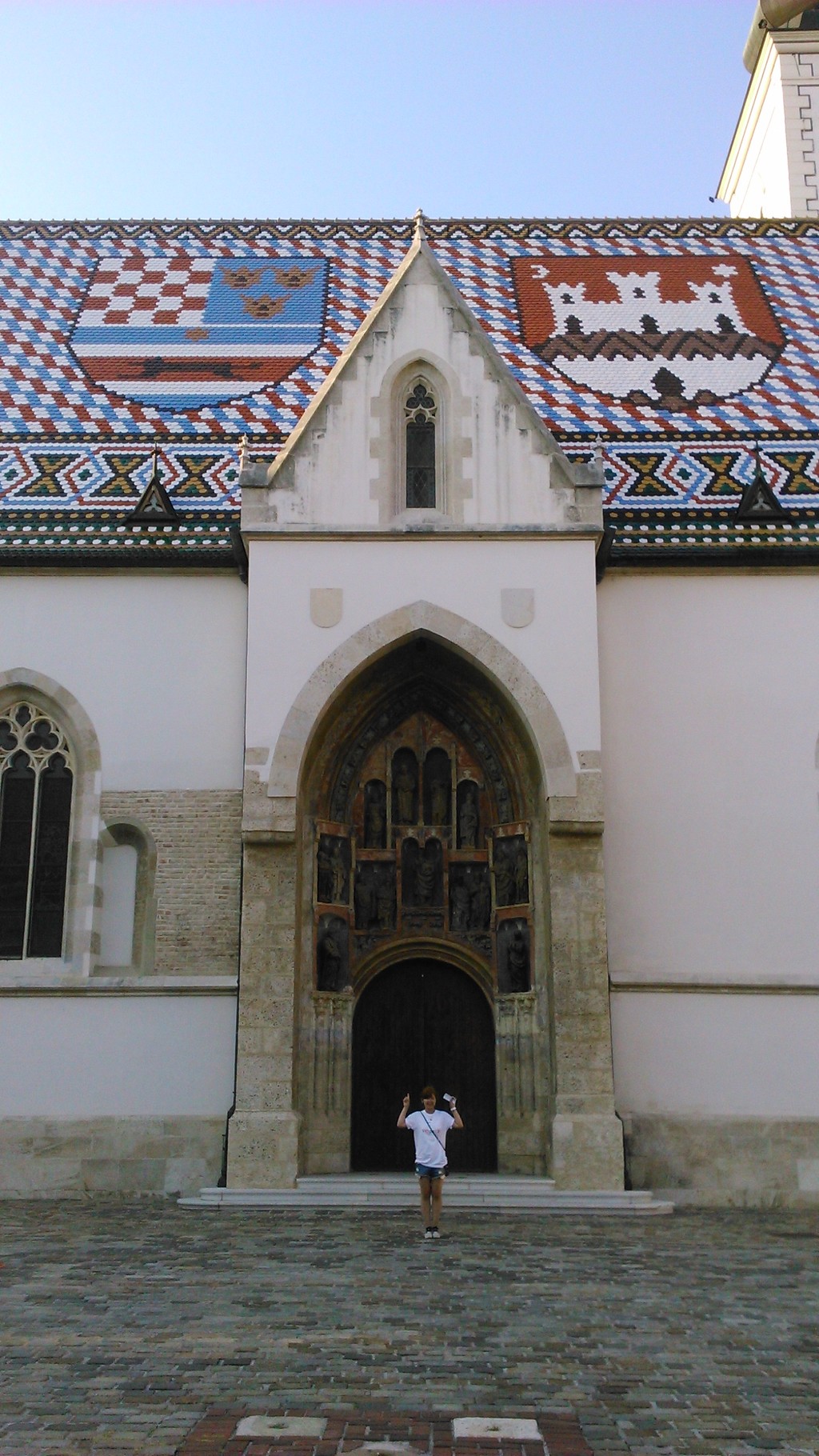
And finally on the square of St Marko! You will likely take photographs of the church. There are a few interesting stories regarding this place. The church is one of the oldest buildings-monuments of Zagreb and dates back to 13th century, the earlierst records. But let's see what you notice first. There is the huge portal (check the picture below) as all the churches more or less have that have the elements of the Romanics, Renaissance and alter Baroque style. On the roof you can see two emblems. The one to the left is the coat of arms of Triuine Kingdom of Croatia, Slavonia and Dalmatia. The one to the right is the emblem of town of Zagreb. As for one interesting story after which was a novel and a film were written it is about the Peasant Revolt of Croatian and Slovene peasants that happened in 16th century. After first successes against the feudal lords the army of the peasants was crushed and its leader - Matija Gubec - was brought in chains here to the Square of St Marko and was sentenced to death by putting the fiery crown on his head. He is seen as one of the national heroes.
After taking pictures we went now to the right through Kamenita ulica (Stone Street) until reaching the Kamenita vrata (Stone Gate).
The story of Kamenita vrata
Kamenita vrata are as well one of the most preserved monuments and buildings of the old Zagreb and Upper Town. It is a passage today and it used to serve as a part of the defense system and walls back in the medieval ages. They were probably built in the 14th century which makes them about 700 years old. Today you will find there a painting of Holy Mother of God, lots of tiles on the walles with the thankful messages and people praying in the corner. Here comes another story that explains the mystery.
There once broke out a huge fire in Zagreb in 1731 and at this place everything except for the image of Holy Mother of God survived. Since then she became the protector of Zagreb.
Alright, after leaving the Stone Gate we are now heading for the stairs and make a circle entering Radićeva Street which now leads us down to the main square.
Tkalča Street and the Main Square of ban Jelačić
On our way down the street towards the main square we passed by the street Krvavi most (Bloody bridge) which links Radićeva Street with Tkalčićeva (Tkalča) Street. And there is a story behind the name of the street as you can guess. Once in the past, when the two historic cores of Zagreb, the two hills and settlements, Gradec which was inhabited by the merchants and "common" citizens and Kaptol - where the cathedral and the priest lived, had been fighting inbetween for a quiet long time and once the things got serious that there was a fight on the bridge upon the creek that was dividing these two little towns. And there was blood. That's it.
I wanted to show Madoka Tkalča as it is resembles the Old Zagreb and has some pretty preserved old houses and residental buildings that will turn you back a century or more earlier. And it is one of the most popular streets in Zagreb where you can go out for a drink, clubs or even to a cinema at the end. Unfortunately, as I am writing this right now I have found out that the cinema is going to be closed from today on...
At the place where Krvavi most street enters into Tkalča Street you can find a giant painted egg which represents actually one of the artwork of Croatian Naive Art. Now, being done with the quick tour of Tkalča we went down to the Main Square.
The buildings here around the main square are one of the tallest in the center and might remind you a bit of Vienna where everything is 1-2 floors bigger than in Zagreb.
The moment you see the main square is at the end of Tkalča street and the square is to your right. To your left though are the stairs that lead to the market place and above the market place. It is called Dolac and one of the symbols of Zagreb I might add as well. It is one of the biggest market places in the center and in general. During the opening hours you can see lots of red sun umbrellas and from above they all resemble the traditional Šestine umbrellas (also one of the symbols of Zagreb).
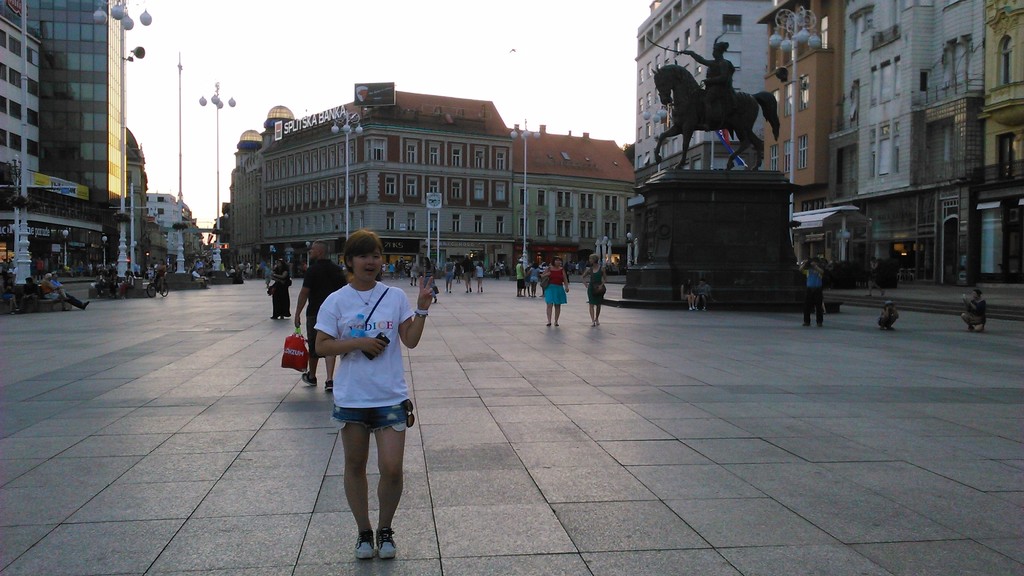
The sun was almost behind the buildings so while being on the main square you could not see the colors of the buildings around. In the middle of the square there is the statue of ban (viceroy) Josip Jelačić who is turned in the direction of south. Another story here - since ban Jelačić has much with the history and is also regarded as one of the national heroes he was an important figure of 19th century. Due to the fights with Hungarians (politicial situation back in the time) the statues was later originally put in direction of Hungary, to the north. Later on his statue was removed from the square during Yugoslavia and after 90s was brought back to the main square but this time to the south.
From the main square you can now have 6 directions or streets leading you somewhere else. Three of them you already know - Ilica, Radićeva and Tkalča where we got from. The rest of them are the Praška street which also has a tram line that leads to the south and the Main railwaystation (Glavni kolodvor) where we will be headin soon. The other one is Jurišićeva Street that goes to the east, also with a tram. And the last is the one that can lead to the cathedral or Square of Europe.
Zagreb's Cathedral
We took the path leading us up to the Cathedral. You will have to climb up a little bit and it takes cca 3-4 minutes from the center of the main Square till the square in front of the Cathedral. The first thing right at the corner that you are going to notice is the model of Zagreb's Old town and center, of Gradec and Kaptol and their close surroundings... If you are a fan of models (or "maketa" as we would say) then I recommend you to take a break and stop there for a few minutes. It is a relief model and with lots of details. I heard it was someone from my School of Design who participated in realization of this project. There is also a metal ball in the corner with "welcome" being expressed in many languages.
Climbing up further and we pass by the street leading you to Dolac and the Greek restaurant. And now finally in front of the cathedral!
You will probably notice some flags that represent hmm Vatican and something else (if I remember). Except for the huge cathedral there are the walls that survived from the medieval ages and might remind you of Romanics or renaisance with the shape of the top of the towers.
Zagreb's Cathedral has two towers which are still under construction. The truth is, they have been under construction since the big earthquake that hit Zagreb at the end of 19th century when half of the town was in ruins and the cathedral had to be reconstructed (here is the name of Austrian architect Herman Bolle of importance). The church was initially Romanic and of Renaissance style with much different look before the catastrophe. It's roots and foundation date back to the Medieval ages. It was once destroyed when the Huns/Mongols with Atila raided Europe and came even to Zagreb (but were stopped on the coast). After the earthquake the architect decided to do it in Neo-gothic style which was kind of a popular trend 100 years ago (neo-gothic, neo-baroque... ). This cathedral is also the tallest building in Croatia with more than 100 meters height.

There is a huge portal but when I wanted to show Madoka the interior it was not possible since the gates were closed. One has to check online when the doors of the cathedral are opened to get in. And the entrance is free. I went there a few weeks later with another friend and actually forgot that is has been pretty long time since I had been there earlier (more than 6-7 years at least, if not 10 haha). There inside you will find a text on the right wall written in the huge glagolitic script and lots of sculptures. At the end of the passage is the grave of archbishop Stepinac.
But who cares about it now. In front of the Cathedral there is also a fountain or well with the tall column and the golden sculpture of Holy Mother of God on the top of it.
Through Opatovina and Dolac back to the Main Square
We went a bit up and passed by the Komedija Theater until reaching the Opatovina Street. There at its end is the Tolkiens House cafe bar which is of course decorated with the motives from Tolkien's world. Now we go towards Dolac and there are shops on both sides, mostly souvenirs. The market place was already closed and nothing was there except for the statues of Petrica Kerempuh. He is the main storyteller of Balads of Petrica Kerempuh where he tells the reads about the difficulties and problems the Croatians have had throughout the history, regarding the Northern regions, and is the masterpiece of Miroslav Krleža and one of the classics of 20th century.
Park Zrinjevac
There was still some sun left, probably less than an hour till the evening and darkness. Thus I wanted to go quickly via Praška Street to the Park Zrinjevac and the Main Railway station.
Zrinjevac is one of the places in the center you have to check when visiting Zagreb. It looks beautiful during all the seasons and in spring and summer is one of the favorite places to sit on the grass in the groups or alone. You can find lots of youth gathering there, sometimes drinking (what else) and playing guitar. There is a fountain in the middle along with a pavilion where throughout the year numerous concerts are being played. In Winter is the place especially popular with lots of small wooden houses selling food and drink during the holidays and the live music which will call you for a dance.
Square of King Tomislav and the Main railway station
It takes about 7-8 minutes max from the main square till the main railway station. And there is the green area all the way down to it. Zrinjevac is actually the beginning of the urban plan (not entirely realized) called 'the horseshoe' which would include several parks (Zrinjevac, Square of King Tomislav, Botanic Garden and the area around the National Theater) and that's the shape as seen from above. The name of this project is 'Lenucci's Horseshoe'. While walking towards the Square of King Tomislav you will pass by the Croatian Academy of Science and Arts and afterwards see a bit lowered terrain (under the road level) with more fountains and banks to sit on. This is now the area around King Tomislav's square and it is very popular in summer when many students and tourists lay down on the grass and in the shadows of the trees.
There is the statue of King Tomislav (first Croatian king from 925 who united the Kingdom of Croatia, than in south of Sava, with the region of Pannonia or modern Slavonia). On the other side of the road is the Main Railway Station (Glavni kolodvor) which was built in the 19th century and is one of the typical examples of Austro-Hungarian style.
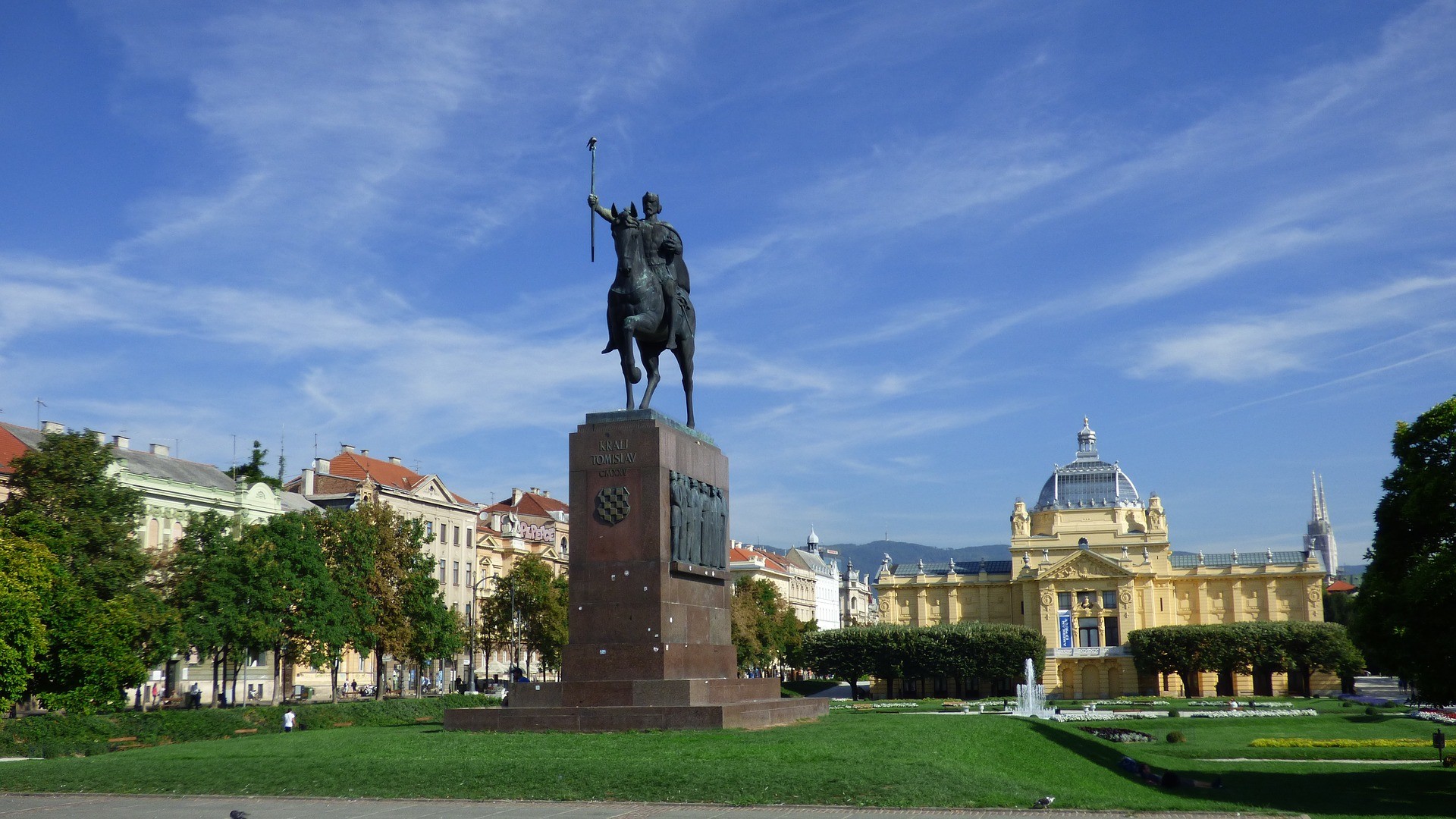
If you look to your right you will see the hotel Esplanade which is also about 100 years old and is said to be one of the elite hotels. Actually, it was built with a specific purpose indeed. Right next to the railway station in order to accept the foreign diplomats and important political guests who would arrive to Zagreb's station. Of course, after decades it has changed. It might be one of the most expensive hotels (for our standards) in Zagreb. I have never been in any of the rooms of course but had a chance to enter it behind the entrance doors twice this year when my foreign friends were visiting Zagreb.
Speaking of Lenucci's Horseshoe, right behind the Hotel Esplanade there is the Botanic Garden of Zagreb which is closed in winter and opened for visitors from spring. Following it you will pass by the State's Archive building and soon arrive through Vodnikova Street to our big and long Savska Street.
If you remember what I wrote long time ago half a minute of scrolling up about sudden change in the urban landscape - if we cross the main railway station now the old architecture would suddenly disappear and we would see the social realism architecture again which will probably not impress you.
Back home for the dinner with grandparents and prepare for tomorrow
We took the tram that led us back to my grandparents near Jarun now being hungry and there had been welcome with delicious dinner. The time came now to go back to Novi Zagreb to our apartment to pack the stuff and prepare Madoka for tomorrow as she was going to leave Zagreb for Slavonia and spend 10 more days with another host family.
Unfortunately there was not enough time to go visit Jarun or Maksimir but hey - in one afternoon and evening, about 3 hours, we managed to see almost everything in the center and the Upper Town, and managed not to collapse dead tired as it was warm too. We leave it for the next time. :-)
Time to say sayounara
And there we go. After breakfasting we headed back to grandparents for the lunch. We left the stuff at home in Novi Zagreb though not to bother carrying them there and back. Time for the photographs and to leave slowly not wanting to miss the bus.
We picked up the stuff at our apartment in Novi Zagreb and headed to the beautiful Bus Terminal. Came 15 minutes earlier and I checked at the driver if everything is okay with the chosen destination and to warn Madoka not to go out somewhere else at the wrong station. The trip of about 3-4 hours awaited her (not much though now but for us can be pain in the ass sometimes haha). Time to say arigatou gozaimashita and
sayounara
The last selfie in front of the bus and that is it.
We had awesome 10 days and we hope she enjoyed the trip around Croatia, precisely the coast in Dalmatia, the important places and the capital in the end. And I learned a lot and met new friends too.
Thanks for reading!
Photo gallery
Content available in other languages
Want to have your own Erasmus blog?
If you are experiencing living abroad, you're an avid traveller or want to promote the city where you live... create your own blog and share your adventures!
I want to create my Erasmus blog! →





























Comments (0 comments)